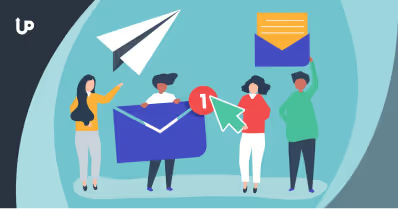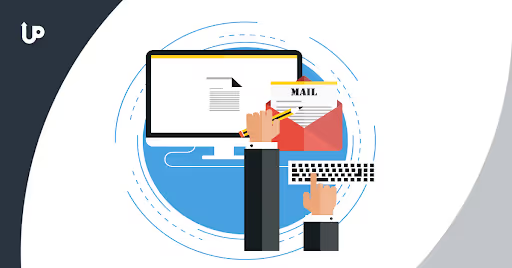Learning how to write a newsletter is an important marketing skill. It allows you to inform and engage your leads, and it gives you opportunities to promote your product or service and provide updates related to your business.
If you’re trying to figure out what to send your leads after capturing them, a newsletter email would be an excellent idea. It’s a common type of email that businesses send to keep their leads interested.
This article walks you through email newsletters — their purpose, structure (what makes up a newsletter), and tips to help you write newsletters that your prospects will enjoy reading.
What is the Purpose of an Email Newsletter?
An email newsletter is a regularly occurring email that’s designed to update subscribers on the latest or best content you have to offer. A newsletter can include things like:
- Your recently published blog posts and videos
- Case studies (your customers’ success stories)
- Upcoming webinars or trainings (or past recordings)
- The best industry tips and practices
- New product launches, deals, and promotions
For example, The Daily Tonic is a newsletter that promises “to bring the best wellness content on the web.” Each email starts with a relevant wellness quote, followed by a list of the latest topics and tips that are backed by studies. It also suggests relevant podcast episodes that dive deeper into a topic or offer readers products that they might be interested in.

As you can tell, newsletters are vital to your overall email marketing strategy. They support a lot of marketing goals. For example, driving more traffic to your website (or other channels you own), providing better experiences to your audience, and establishing yourself as an industry expert.
Plus, you’re able to nurture your leads effectively since you communicate with them directly. That said, you’ll want to make sure that your emails are written in such a way that compels them to read and take action.
Before we discuss how you can write a great newsletter email, let’s discuss the proper newsletter structure.
How Do You Structure a Newsletter?
Every newsletter follows a certain structure. Make sure your newsletter has the following elements:
Subject line
This is the line of text that comes after the sender’s name. It can determine whether people open and read your newsletter email, so make it count. A well crafted subject line is short and piques a recipient’s curiosity.

Body
This is the actual text found within your email, which includes your main message and call-to-action. It can be short or long depending on the content you want to provide. Some email bodies limit their text to 200 words, while others — especially emails that list their top blog posts or discuss the latest industry updates — can reach as many as 1,000 words.
No matter the length, keep your newsletter readable and properly formatted. Use short paragraphs, bullet points, or an email template that breaks your email into sections to help you save time.
Call-to-action
A call-to-action or CTA is the thing that you would like your subscribers to do. This can include reading your article, checking out your product, or answering a survey. Below is an example of a call-to-action in the body of an email:

Footer
This section at the bottom of your email includes more information about your business. You can include things like your company address, contact number, copyright information, and links to your social media profiles.
An important element that should be in every footer is the unsubscribe link or button. This gives your subscribers the option to opt out of your newsletter if they decide they no longer wish to hear from you.
How to Write a Newsletter Email (Tips to Write Effective Newsletters)
Let’s go through some strategies you can use to write a good newsletter that gets results for your business.
Know your goals.
Before you start planning your email newsletter content, think about what you desire to achieve through your newsletter.
These goals usually fall under two categories — relationship building and monetization (getting people to buy your product or service). Having specific goals gives direction and focus to your emails.
Of course, you can set as many goals as you want and even change these goals over time. The key is to make them realistic and attainable. Examples of goals are:
- Driving traffic to your website
- Increasing your sales
- Educating your audience and positioning yourself as an expert
- Understanding your audience better
- Promoting other channels (your YouTube channel, podcast, etc.)
Get creative with your email subject lines.
A successful newsletter email begins with a subject line that stirs curiosity. Research reveals that 33% of people open an email because of a catchy subject line. Furthermore, 69% will mark an email as spam because of the subject line alone.
This goes to show how important email subject lines are.
Fortunately, there are plenty of ways to make a subject line stand out. A basic rule is to keep it as short but as descriptive as possible. Use no more than 9 words to ensure that people can read the entire subject line from their mobile devices.
For example, a short and descriptive subject line could be something like, “10 alternatives to traditional home buying” or “Great protein sources for vegetarians and vegans” or “5 finds for Mother’s Day, handpicked by our team.”
Other strategies may include adding relevant emojis, personalization (by including their first name or mentioning their interest), and asking and intriguing question.
To learn whether your subject lines are effective, do A/B testing. You can also try this free email subject line tester by CoSchedule. Simply type in your subject line to get a score and recommendations to improve it.

Draw them in with your opening line.
After getting people to open your email, hook them with your open line. The opening line refers to the beginning sentence which sets the tone for the rest of your email.
For instance, in their email, Yoast writes, “SEO isn't just a trick. Ranking well in Google, in the long run, asks for a holistic SEO strategy focused on every aspect of your website.”
See the screenshot below:

On the other hand, a newsletter that’s a roundup of popular articles should emphasize this in the opening line. For example, Thrive writes, “A curated selection of our favorite reads — with actionable tips for enhancing your well-being, productivity, and sense of purpose.”
See the screenshot below:

Focus on helping them.
Now, it’s time to connect with your reader from the body of your email.
For emails that discuss one topic and require more length, be sure to keep it focused and readable. Include important takeaways and break it up into several paragraphs with relevant headings so that people don’t miss out on valuable information.
Whatever is in your email, it should make your readers feel that they can gain something from it — a piece of advice, solution, or remedy that helps them overcome a problem (or avoid it).
Decide on the right frequency.
“How often should I be sending out an email newsletter?” This is a question frequently asked by businesses new to email marketing. Learning how to write a newsletter also includes choosing the right sending frequency.
While there’s no one definitive answer, the key is to ensure that people hear from you on a regular basis. It means that you can email them once a week or once every two weeks (2x a month). Stick to your frequency so they know when to expect your emails.
Also, here’s a pro tip: Provide a link within your email that links to a preference center. On the preference center page, let them choose their desired email frequency. This way, they won’t get overwhelmed with multiple emails. They’re also less likely to hit unsubscribe.
Make it easy for people to unsubscribe.
Reducing email unsubscribes is something that every business wants. However, it’s actually a good idea to not keep disinterested people on your list. This is because unengaged contacts may negatively affect your other email metrics such as conversions.
So, always include an option to unsubscribe from your newsletter. It’s a basic email marketing practice and one of the ways to improve email deliverability.
Here’s a screenshot that shows the unsubscribe link in the footer section of Slack’s email:

Review and analyze your results.
Don’t forget to measure the effectiveness of your email newsletter by looking at important email marketing metrics. These metrics include your:
- Open rate: this is the percentage of recipients who open your emails. Your subject lines can have an impact on your open rates.
- Click-through rate: this reflects the percentage of people who are clicking through a link or call-to-action within your email.
- Conversion rate: this is the percentage of subscribers who take action after reading your email and it affects your return on investment (ROI).
When you figure out why your emails aren’t performing well, you can easily make the necessary changes — or replicate your strategies for emails with high conversions.
Conclusion
Newsletters are an effective means of maintaining communication and marketing to your email subscribers.
In fact, if you’ve collected leads using an UpViral campaign (a referral or giveaway contest, for example) we encourage you to engage with them right away to avoid losing their interest and start getting conversions.
If you don’t know how to write a newsletter, these tips will give you a headstart. Begin by identifying your newsletter goals, working on enticing subject lines, and making your email content as helpful as possible. Finally, measure the results of your newsletters by observing important metrics.
However, if you’re still in the process of growing your email list and need help, we invite you to get started with UpViral. In the meantime, you can also check out our free in-depth case studies to learn how other successful UpViral users have done it!





.png)